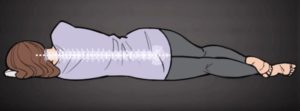It’s not just how dark your room is or how much smooth jazz you play before you glide into the land of dreams. But, how to sleep on your side correctly?
How to sleep on your side correctly: Side sleepers with correct spinal alignment
Everyone has an inclination to one or the other position, but side sleepers are the most common in the group. Although sleeping on the back is ideal for supporting the spine, sleeping from the side is the next best thing. Doctors even recommend side sleep over the back for all women with a roll in the oven, and for sleepers who are prone to snoring or sleep apnea.

But that doesn’t mean that everything in the bedroom is good and beautiful. Side sleepers can throw and turn more than back sleepers, which leads to poorer sleep quality. They also suffer from frequent right or left shoulder pain, neck pain and back pain. This position has been shown to cause more wrinkles and even sagging breasts.
Although we can’t do much for the girls above, we can give you some inside information on how to sleep on your side, and give you some tips on how to sleep better and wake up more rested.
How to sleep on the side
When you sleep on your side, the best alignment of the spine is straight. If your spine bends, it’s exhausting. If your spine is kept in an unnatural position for hours (e.g. when you are at work or asleep), this leads to frequent pain.
If you sleep on your side, you need a mattress that supports your curved areas: Your neck and your waist. Because the muscles and ligaments of your back relax and heal while you sleep. Good posture is important to protect your back, and supporting these areas helps you to align your spine during this time of recovery.
What is the best mattress for side sleepers?
7 tips for side sleepers
-
- Find a mattress that supports your body – this has the greatest influence on sleep quality. If you cannot replace your mattress with a mattress that better supports your body, use a small rolled towel to fill the space under your rounded areas: under your neck and waist. This can help alleviate some pain from sleeping with your tense spine.
- The best mattress for side sleepers is gentle to the shoulders – Your hips and shoulders get the main load of pressure when you are a side sleeper. Find a mattress that is supportive but also gentle under your pressure points.
- Get the right pillow for side sleepers – pillows are not just for the head and neck, they keep your entire spine in the right position while you sleep. Your pillow should support the natural curvature of your neck – your head should not lean down or be supported too high. A good rule of thumb is that ear, shoulder and hip should be aligned.
- Test the pillows until they are perfect – If you have large shoulders, you need a larger pillow. A pillow that is too high or too flat can lead to muscle strain on the back, neck and shoulders. The ideal pillow is adjustable so you can sleep comfortably in different positions.
- If your thigh is not properly supported, it can pull down, pull your spine out of alignment, and strain your hips and lower back. To relieve this stress, sleep with a small, thin cushion between your knees and pull your knees slightly towards your chest. But beware of the fetal position too close and you can lap your lower back.
- A further pillow recommendation – If you are a restful gastric sleeper, you can add a pillow under your armpit to mimic the feeling of sleep on your stomach. Stomach sleep is known as the worst sleeping position, so you will want to do whatever you can to take a side or back position instead.
- Do your morning stretches – everyone can benefit from a good morning stretch, and side sleepers are no exception. Since many side sleepers curl up in the child position, stretching in the morning will reduce muscle tension and improve mood.
Who follows the rules of the so-called sleep hygiene, often saves the medicamentous helping.
The top tips of sleep researchers:
- Do not smoke just before going to bed or when waking up at night.
- Do not eat heavy meals late at night. A small bedtime sweater can have a sleep-inducing effect.
- Do not exercise for six hours before bedtime. Moderate
- Movement such as an evening walk can, however, encourage falling asleep.
- Do not drink caffeinated drinks or alcohol for four to six hours before going to bed.
Ensure the right temperature in the bedroom: 14 to 18 degrees are optimal. - If possible, always go to bed at the same time and get up at the same time – even at the weekend.
- Make sure your bedroom is dark and quiet.
- Do not stay in bed after waking up in the morning, but out of bed. It is best to spend a few minutes in daylight, for example on the balcony.




